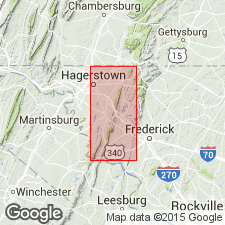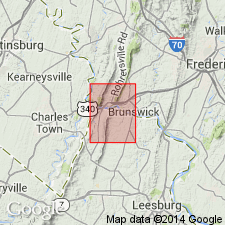
- Usage in publication:
-
- Bolivar Heights Member
- Modifications:
-
- Named
- Dominant lithology:
-
- Limestone
- Marble
- AAPG geologic province:
-
- Appalachian basin
Summary:
Named the Bolivar Heights Member of the Tomstown Formation in MD, PA and WV for Bolivar Heights, near Harpers Ferry, Jefferson Co., WV. Unit extends from the WV-VA state line northward into southern PA. Consists predominantly of dark-gray, bioturbated and sheared limestone with white, mylonitic marble (Keedysville marble bed) near the base. Thickness is 200 to 250 feet. Overlies the Antietam Formation and underlies the Fort Duncan Member of the Tomstown. Lower contact with Antietam is rarely exposed and is almost always a thrust contact. Upper contact is above burrow-mottled limestone and beneath dolomite of overlying Fort Duncan Member. The Bolivar Heights is of Early Cambrian age.
Source: GNU records (USGS DDS-6; Reston GNULEX).

- Usage in publication:
-
- Bolivar Heights Member*
- Modifications:
-
- Areal extent
- AAPG geologic province:
-
- Appalachian basin
Summary:
Geographically extended the Bolivar Heights Member of the Tomstown Formation into northern VA. In VA, WV, and MD, the Bolivar Heights consists of medium dark-gray, dark gray to brownish-black, thin to thick, locally nodular bedded limestone containing olive-gray to olive-black burrows, locally anastomosing. Basal 15 meters contains a pinkish-gray to light-gray laminated marble. Thickness is approximately 65 meters. Overlies the Antietam Formation and underlies the Fort Duncan Member of the Tomstown.
Source: GNU records (USGS DDS-6; Reston GNULEX).
For more information, please contact Nancy Stamm, Geologic Names Committee Secretary.
Asterisk (*) indicates published by U.S. Geological Survey authors.
"No current usage" (†) implies that a name has been abandoned or has fallen into disuse. Former usage and, if known, replacement name given in parentheses ( ).
Slash (/) indicates name conflicts with nomenclatural guidelines (CSN, 1933; ACSN, 1961, 1970; NACSN, 1983, 2005, 2021). May be explained within brackets ([ ]).

